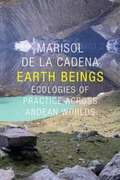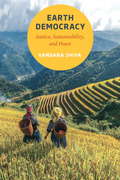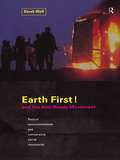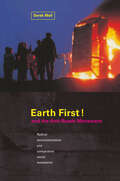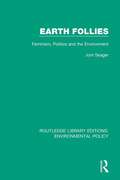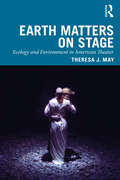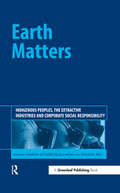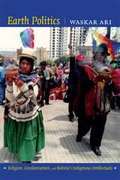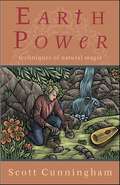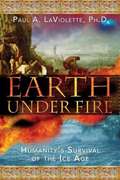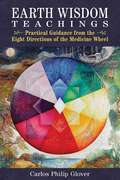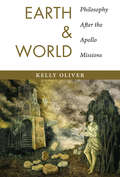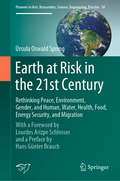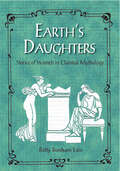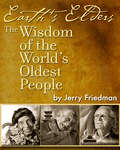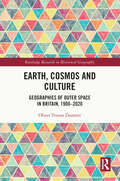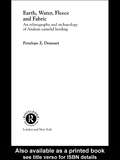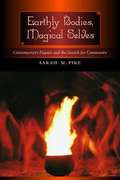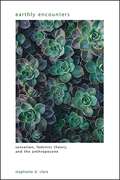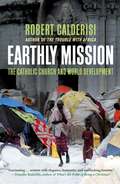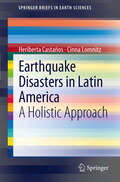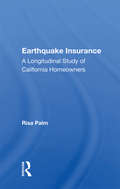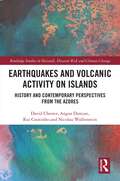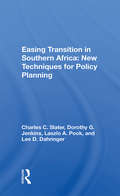- Table View
- List View
Earth Beings: Ecologies of Practice across Andean Worlds
by Robert J. Foster Marisol de la Cadena Daniel R. ReichmanEarth Beings is the fruit of Marisol de la Cadena's decade-long conversations with Mariano and Nazario Turpo, father and son, runakuna or Quechua people. Concerned with the mutual entanglements of indigenous and nonindigenous worlds, and the partial connections between them, de la Cadena presents how the Turpos' indigenous ways of knowing and being include and exceed modern and nonmodern practices. Her discussion of indigenous political strategies--a realm that need not abide by binary logics--reconfigures how to think about and question modern politics, while pushing her readers to think beyond "hybridity" and toward translation, communication that accepts incommensurability, and mutual difference as conditions for ethnography to work.
Earth Democracy
by Vandana ShivaWorld-renowned environmental activist and physicist Vandana Shiva calls for a radical shift in the values that govern democracies, condemning the role that unrestricted capitalism has played in the destruction of environments and livelihoods. She explores the issues she helped bring to international attention--genetic food engineering, culture theft, and natural resource privatization--uncovering their links to the rising tide of fundamentalism, violence against women, and planetary death. Struggles on the streets of Seattle and Cancun and in homes and farms across the world have yielded a set of principles based on inclusion, nonviolence, reclaiming the commons, and freely sharing the earth's resources. These ideals, which Dr. Shiva calls "Earth Democracy," serve as an urgent call to peace and as the basis for a just and sustainable future.From the Trade Paperback edition.
Earth First! and the Anti-Roads Movement: Radical Environmentalism And Comparative Social Movements
by Derek WallEarth First! is one of the most controversial and well known green movements in the world and the driving force behind the anti-road campaigns of the 1990s, made famous by sabotage tactics. Detailed accounts of major anti-road campaigns both in the UK and internationally are included, describing confrontations at Twyford, Newbury, Glasgow, the Autobahn in Germany, and information on the international spread of the Earth First! movement, with details of campaigns in Australia, Ireland, Germany, France, Holland and Eastern Europe. Earth First! and the Anti-Roads Movement traces the origins of the movement and the history of anti-roads activism in Britain since the 1880s. Radical EF! organisers describe how they took on their green activist identity, why they launched both EF! and the anti-roads movement, and their experiences of dramatic protest. Exposing the tensions between EF! and other green activists, they explain the political and economic influences on and the culture and politics of protest. Showing how green social and political theory can be linked to practical struggles for environmental and social change, Derek Wall investigates key topics of political and sociological interest in Britain and the World today. This is an authoritative account based on passionate and lyrical autobiographical accutns form activists blended with a strong theoretical grounding.
Earth First:Anti-Road Movement
by Derek WallFirst published in 1999. Routledge is an imprint of Taylor & Francis, an informa company.
Earth Follies: Feminism, Politics and the Environment (Routledge Library Editions: Environmental Policy #11)
by Joni SeagerFirst published in 1993. The question of ‘agency’ is essential to our understanding of environmental problems - who is responsible, and why? Threats such as ozone depletion, global warming and overconsumption are all precipitated by the powerful institutions which shape modern life – institutions which are overwhelmingly controlled by men and dominated by masculine presumptions. Joni Seager argues that the gender bias inherent in western culture is inextricably linked to our environmental crisis. She analyses the traditional institutes of power – governments, the military and transnational corporations - and also takes a critical look at the equally patriarchal environmental establishment, comparing the work of the official environmental movement, grounded in masculine thought, with the smaller-scale, direct actions taken by women driven to protect their homes and communities. Earth Follies represents an incisive and utterly convincing feminist critique of our environmental crises, and offers radical and productive priorities for the environmental agenda.
Earth Matters on Stage: Ecology and Environment in American Theater (Routledge Studies in Theatre, Ecology, and Performance)
by Theresa J. MayEarth Matters on Stage: Ecology and Environment in American Theater tells the story of how American theater has shaped popular understandings of the environment throughout the twentieth century as it argues for theater’s potential power in the age of climate change. Using cultural and environmental history, seven chapters interrogate key moments in American theater and American environmentalism over the course of the twentieth century in the United States. It focuses, in particular, on how drama has represented environmental injustice and how inequality has become part of the American environmental landscape. As the first book-length ecocritical study of American theater, Earth Matters examines both familiar dramas and lesser-known grassroots plays in an effort to show that theater can be a powerful force for social change from frontier drama of the late nineteenth century to the eco-theater movement. This book argues that theater has always and already been part of the history of environmental ideas and action in the United States. Earth Matters also maps the rise of an ecocritical thought and eco-theater practice – what the author calls ecodramaturgy – showing how theater has informed environmental perceptions and policies. Through key plays and productions, it identifies strategies for artists who want their work to contribute to cultural transformation in the face of climate change.
Earth Matters: Indigenous Peoples, the Extractive Industries and Corporate Social Responsibility
by Ciaran O'Faircheallaigh Saleem AliIndigenous peoples have historically gained little from large-scale resource development on their traditional lands, and have suffered from its negative impacts on their cultures, economies and societies. During recent decades indigenous groups and their allies have fought hard to change this situation: in some cases by opposing development entirely; in many others by seeking a fundamental change in the distribution of benefits and costs from resource exploitation. In doing so they have utilised a range of approaches, including efforts to win greater recognition of indigenous rights in international fora; pressure for passage of national and state or provincial legislation recognising indigenous land rights and protecting indigenous culture; litigation in national and international courts; and direct political action aimed at governments and developers, often in alliance with non-governmental organisations (NGOs). At the same time, and partly in response to these initiatives, many of the corporations that undertake large-scale resource exploitation have sought to address concerns regarding the impact of their activities on indigenous peoples by adopting what are generally referred to as "corporate social responsibility" (CSR) policies. This book focuses on such corporate initiatives. It does not treat them in isolation, recognising that their adoption and impact is contextual, and is related both to the wider social and political framework in which they occur and to the activities and initiatives of indigenous peoples. It does not treat them uncritically, recognising that they may in some cases consist of little more than exercises in public relations. However, neither does it approach them cynically, recognising the possibility that, even if CSR policies and activities reflect hard-headed business decisions, and indeed perhaps particularly if they do so, they can generate significant benefits for indigenous peoples if appropriate accountability mechanisms are in place. In undertaking an in-depth analysis of CSR and indigenous peoples in the extractive industries, the book seeks to answer the following questions. What is the nature and extent of CSR initiatives in the extractive industries and how should they be understood? What motivates companies to pursue CSR policies and activities? How do specific political, social and legal contexts shape corporate behaviour? What is the relationship between indigenous political action and CSR? How and to what extent can corporations be held accountable for their policies and actions? Can CSR help bring about a fundamental change in the distribution of benefits and costs from large-scale resource exploitation and, if so, under what conditions can this occur? Earth Matters gathers key experts from around the world who discuss corporate initiatives in Alaska, Ecuador, Australia, Canada, Peru, Papua New Guinea, Indonesia and Russia. The book explores the great diversity that characterises initiatives and policies under the name of "corporate social responsibility", the highly contingent and contextual nature of corporate responses to indigenous demands, and the complex and evolving nature of indigenous–corporate relations. It also reveals much about the conditions under which CSR can contribute to a redistribution of benefits and costs from large-scale resource development. Earth Matters will be essential reading for those working in and studying the extractive industry worldwide, as well as those readers looking for a state-of-the-art description of how CSR is functioning in perhaps its most difficult setting.
Earth Politics: Religion, Decolonization, and Bolivia’s Indigenous Intellectuals
by Waskar AriEarth Politics focuses on the lives of four indigenous activist-intellectuals in Bolivia, key leaders in the Alcaldes Mayores Particulares (AMP), a movement established to claim rights for indigenous education and reclaim indigenous lands from hacienda owners. The AMP leaders invented a discourse of decolonization, rooted in part in native religion, and used it to counter structures of internal colonialism, including the existing racial systems. Waskar Ari calls their social movement, practices, and discourse earth politics, both because the AMP emphasized the idea of the earth and the place of Indians on it, and because of the political meaning that the AMP gave to the worship of the Aymara gods. Depicting the social worlds and life work of the activists, Ari traverses Bolivia's political and social landscape from the 1920s into the early 1970s. He reveals the AMP 's extensive geographic reach, genuine grassroots quality, and vibrant regional diversity. Ari had access to the private archives of indigenous families, and he collected oral histories, speaking with men and women who knew the AMP leaders. The resulting examination of Bolivian indigenous activism is one of unparalleled nuance and depth.
Earth Power: Techniques of Natural Magic
by Scott CunninghamThis tried-and-true guide offers more than one hundred spells, rites, and simple rituals you can perform using the powerful energy of the earth.Here is magic that anyone can work with surprising results. It is the magic of nature—positive magic for positive solutions. When we look to the Earth, we discover answers that have been there all along.Within these pages you will find your own magician’s handbook. Your tools cost nothing and they are easy to obtain: the earth, fire, water, air…stones, trees, rain, and fog. Some of the tools, like mirrors, ropes, and candles, are linked with and tap into the power of nature by their symbolism. Each spell and divination is outlined in detail.When you practice any of the magic contained in this book, whether drawing a heart in the sand, gazing into a mirror for a glimpse of the future, or tying a knot to help a troubled friend, keep in mind the higher aspects of your workings. You are improving the world and helping to heal the ravages it has suffered. When we change ourselves, we change the world. It is this which makes the practitioner of natural magic truly divine.Includes more than 100 spells, rituals, and divinationsProvides the principles for performing effective magicInstills a sense of wonder concerning our planet and our livesPromotes a natural, positive practice that anyone can successfully perform
Earth Under Fire: Humanity's Survival of the Ice Age
by Paul A. LavioletteAnother book in a series of books on quantum physics exploring the construct of our universe. this book covers the coming galactic changes.
Earth Wisdom Teachings: Practical Guidance from the Eight Directions of the Medicine Wheel
by Carlos Philip Glover• Takes you through the eight directions of the Medicine Wheel to ignite your spirit fire, inspire deeper connection with all life on Earth, and open your creative, sensory, emotional, and intuitive intelligences• Shares practices such as deep listening, healing with the four elements, making death an ally, transforming limiting beliefs, discovering your animal teacher, and accessing inner wisdom• Explains how the transformation of consciousness influences those around you, allowing individual inner work to initiate collective change and ecological healingTHE FUTURE OF HUMANITY is in question, the world is in crisis and the Earth on fire. How can we find the inner strength to meet these challenges from a place of power?Aware that personal transformation serves the collective healing, Carlos Philip Glover takes you on a journey of self-empowerment around the Medicine Wheel of Earth Wisdom — to ignite your spirit fire, awaken new levels of consciousness, and inspire you to meet outer challenges through deep inner work. Each of the eight directions of the Medicine Wheel opens different aspects of your innate inner Earth Wisdom, including heartknowing and your creative, sensory, emotional, and intuitive intelligences. Experiential exercises and meditations allow you to grow and deepen your relationship with the Earth and all life on it. By accessing the wisdom of your body-mind and heart-knowing you can meet this time of great change with clarity and courage.Illustrated with heartful stories and inspiring images, Earth Wisdom Teachings is a practical guide for anyone who longs for a deeper relationship with Earth and Spirit and wants to contribute to the awakening of consciousness.
Earth and World
by Kelly OliverCritically engaging the work of Immanuel Kant, Hannah Arendt, Martin Heidegger, and Jacques Derrida together with her own observations on contemporary politics, environmental degradation, and the pursuit of a just and sustainable world, Kelly Oliver lays the groundwork for a politics and ethics that embraces otherness without exploiting difference. Rooted firmly in human beings' relationship to the planet and to each other, Oliver shows peace is possible only if we maintain our ties to earth and world.Oliver begins with Immanuel Kant and his vision of politics grounded on earth as a finite surface shared by humans. She then incorporates Hannah Arendt's belief in plural worlds constituted through human relationships; Martin Heidegger's warning that alienation from the Earth endangers not only politics but also the very essence of being human; and Jacques Derrida's meditations on the singular worlds individuals, human and otherwise, create and how they inform the reality we inhabit. Each of these theorists, Oliver argues, resists the easy idealism of world citizenship and globalism, yet they all think about the earth against the globe to advance a grounded ethics. They contribute to a philosophy that avoids globalization's totalizing and homogenizing impulses and instead help build a framework for living within and among the world's rich biodiversity.
Earth at Risk in the 21st Century: With a Foreword by Lourdes Arizpe Schlosser and a Preface by Hans Günter Brauch (Pioneers in Arts, Humanities, Science, Engineering, Practice #18)
by Úrsula Oswald SpringEarth at Risk in the 21st Century offers critical interdisciplinary reflections on peace, security, gender relations, migration and the environment, all of which are threatened by climate change, with women and children affected most. Deep-rooted gender discrimination is also a result of the destructive exploitation of natural resources and the pollution of soils, water, biota and air. In the Anthropocene, the management of human society and global resources has become unsustainable and has created multiple conflicts by increasing survival threats primarily for poor people in the Global South. Alternative approaches to peace and security, focusing from bottom-up on an engendered peace with sustainability, may help society and the environment to be managed in the highly fragile natural conditions of a ‘hothouse Earth’. Thus, the book explores systemic alternatives based on indigenous wisdom, gift economy and the economy of solidarity, in which an alternative cosmovision fosters mutual care between humankind and nature.• Special analysis of risks to the survival of humankind in the 21st century.• Interdisciplinary studies on peace, security, gender and environment related to global environmental and climate change.• Critical reflections on gender relations, peace, security, migration and the environment• Systematic analysis of food, water, health, energy security and its nexus.• Alternative proposals from the Global South with indigenous wisdom for saving Mother Earth.
Earth's Daughters: Stories of Women in Classical Mythology
by Betty LiesA "Who's Who" of women in classical mythology! The stories in this collection will not only satisfy the mythology lover and feminine scholar but make an outstanding curriculum supplement for humanities or literatures courses in elementary and high school. They are especially appropriate for courses emphasizing a returning emphasis on classical literature.
Earth's Elders
by Jerry FriedmanIn the creation of Earth's Elders, Jerry Friedman met, interviewed and photographed some of the world's oldest elders - 110 years old or older (supercentenarians, as researchers call them).Jerry Friedman, photographer, author and founder of Earth's Elders, spent four years on a landmark project to introduce the world to the sixty oldest people on earth. Using his lens to capture a community that has never before been documented, the award-winning photographer has shed new light on the "invisible" world of people 110 years and older.With each visit on his globetrotting journey to capture the lives of these "super centenarians," Friedman gained a deeper understanding of what the elderly in every culture have to offer. Inspired by the opportunity to improve the quality of life of the elderly, to teach children to recognize the wisdom and value of the elderly as essential parts of our society, and to improve the health of our communities through intergenerational tolerance and communication, Friedman created Earth's Elders.
Earth, Cosmos and Culture: Geographies of Outer Space in Britain, 1900–2020 (Routledge Research in Historical Geography)
by Oliver Tristan DunnettThis book traces the development of diverse British cultures of outer space, utilizing key geographical concepts such as landscape, place, and national identity. It examines the early visionary ideas of writers H. G. Wells and Olaf Stapledon, the ambitious British space programme of the 1960s, and narrations of British cultural identity that accompanied the space missions of Helen Sharman, Beagle 2 and Tim Peake. The exploration of British cultures of outer space throughout the book helps understand the emergence of the British Interplanetary Society. It also explains its significance in pre-war and post-war periods through an analysis of the roles of influential figures such as Arthur C. Clarke and Patrick Moore. The chapters explore utopian and dystopian representations of space exploration, examine the mysterious phenomenon of UFO culture, and consider plans for humanity’s imagined future across interstellar space. Throughout the book geography is advocated as a home for critical studies of outer space, illuminating its significance in terms of the reciprocal relationships between exploration and the sublime, science and the imagination, Earth and cosmos. As an emergent field of research in the social sciences, this book makes an excellent contribution to the study of the outer space in Britain and abroad developing a distinctive kind of outer spatial geography with major implications for future teaching and research.
Earth, Water, Fleece and Fabric: An Ethnography and Archaeology of Andean Camelid Herding
by Penny DransartThrough a richly detailed examination of the practices of spinning yarn from the fleece of llamas and alpacas, Earth, Water, Fleece and Fabric explores the relationship that herders of the present and of the past have maintained with their herd animals in the Andes. Dransart juxtaposes an ethnography of an Aymara herding community, based on more than ten years fieldwork in Isluga in the Chilean highlands, with archaeological material from excavations in the Atacama desert.Impeccably researched, this book is the first systematic study to set the material culture of pastoral communities against an understanding of the long-term effects of herding practices.
Earthly Bodies, Magical Selves: Contemporary Pagans and the Search for Community
by Sarah M. PikeThis book is the first ever comprehensive study of neo-pagans and modern day neo-pagan festivals. Neo-paganism is the latest of new religions to emerge on the scene, its popularity growing in both Europe and North America as followers attempt to wed environmental concerns with traditional spirituality.
Earthly Encounters: Sensation, Feminist Theory, and the Anthropocene (SUNY series in Gender Theory)
by Stephanie D. ClareEarthly Encounters develops a fuller account of the lived experience of racialized gender formation as it exists on this planet, earth. It analyzes sensations: the chill of winter, the warm embrace of the wind, the feeling of being immersed in water, and a stifling sense of containment. Through this analysis in settler colonial and colonial contexts, in twentieth-century North America and Africa, Stephanie D. Clare shows how sensation is unevenly distributed within social worlds and productive of racial, national, and gendered subjectivities. From revealing the relevance of phenomenology, especially in the writings of Maurice Merleau-Ponty and Frantz Fanon, to debates concerning new materialism and affect theory, Clare shows how the phenomenology of race and gender must consider both the production of the body-subject and the environment. She concludes by making a case for the continued significance of sensation in the context of the Anthropocene.
Earthly Mission
by Robert CalderisiWith 1. 2 billion members, the Catholic Church is the worlds largest organization and perhaps its most controversial. The Churchs obstinacy on matters like clerical celibacy, the role of women, birth control, and the child abuse scandal has alienated many Catholics, especially in the West. Yet in Africa, Asia, and Latin America, the Church is highly esteemed for its support of education, health, and social justice. In this deeply informed book, Robert Calderisi unravels the paradoxes of the Catholic Churchs role in the developing world over the past 60 years. Has the Catholic Church on balance been a force for good? Calderisi weighs the Churchs various missteps and poor decisions against its positive contributions, looking back as far as the Spanish Conquest in Latin America and the arrival of missionaries in Africa and Asia. He also looks forward, highlighting difficult issues that threaten to disrupt the Churchs future social role. The authors answer to the question he poses will fascinate Catholic and non-Catholic readers alike, providing a wealth of insights into international affairs, development economics, humanitarian concerns, history, and theology.
Earthquake Disasters in Latin America
by Cinna Lomnitz Heriberta CastañosThis book is an attempt to demonstrate the analytical power of the holistic approach for understanding disasters. Six major earthquakes in Latin America are used as an example: the general idea is to place disasters in a broad social and regional context. Understanding disasters is a way of understanding the social system. The idea is to show that every major disaster is unique and different. Statistical methods may be useful for purposes of risk estimation but modern disasters are "systemic" and complex. In the chapter on the 2010 Chile earthquake we discuss the tsunami and why the system of tsunami alert did not work. The introductory chapter contains some basics of seismology (plate tectonics) and earthquake engineering. The 1985 Mexico earthquake describes why geology is important. Why was Mexico City founded in a lake? Technology must be adapted to the environment, not "imported" from possibly more advanced but different societies. The 1970 Peru earthquake is an example of disaster in a unique environment. Caracas 1967 takes us on a survey of different engineering solutions. And the 1960 Chile earthquake leads us on a retrospective survey--what has changed in Chile between the two major Chile earthquakes? A discussion on Charles Darwin's observations of the 1835 Chile earthquake provides a fitting summary.
Earthquake Insurance: A Longitudinal Study Of California Homeowners
by Risa PalmThis book explores the nature of the earthquake hazard and the availability of insurance and reports on a longitudinal study of homeowners in four California counties to chart their growing concern with earthquakes.
Earthquakes and Volcanic Activity on Islands: History and Contemporary Perspectives from the Azores (Routledge Studies in Hazards, Disaster Risk and Climate Change)
by David K. Chester Angus Duncan Rui Coutinho Nicolau WallensteinThis volume examines the impact of and responses to historic earthquakes and volcanic eruption in the Azores. Study is placed in the contexts of: the history and geography of this fascinating archipelago; progress being made in predicting future events and policies of disaster risk reduction. This is the only volume to consider the earthquake and volcanic histories of the Azores across the whole archipelago and is based, not only on contemporary published research, but also on the detailed study of archival source materials. The authors seek to show how extreme environmental events, as expressed through eruptions, earthquakes and related processes operating in the past may be considered using both complementary scientific and social scientific perspectives in order to reveal the ways in which Azorean society has been shaped by both an isolated location in the middle of the Atlantic Ocean and the ever present threat of environmental uncertainty. Chapter 2, which analyses in depth the geology and tectonics of the islands is of more specialist interest, but technical terms are fully explained so as to widen the accessibility of this material. The audience for this volume includes all those who are interested in the geology, geography, history and hazard responses in the Azores. It is written, not just for the educated general reader, but for the specialist earth scientist and hazard researcher.
Earthworks Rising: Mound Building in Native Literature and Arts (Indigenous Americas)
by Chadwick AllenA necessary reexamination of Indigenous mounds, demonstrating their sustained vitality and vibrant futurity by centering Native voices Typically represented as unsolved mysteries or ruins of a tragic past, Indigenous mounds have long been marginalized and misunderstood. In Earthworks Rising, Chadwick Allen issues a compelling corrective, revealing a countertradition based in Indigenous worldviews. Alongside twentieth- and twenty-first-century Native writers, artists, and intellectuals, Allen rebuts colonial discourses and examines the multiple ways these remarkable structures continue to hold ancient knowledge and make new meaning—in the present and for the future.Earthworks Rising is organized to align with key functional categories for mounds (effigies, platforms, and burials) and with key concepts within mound-building cultures. From the Great Serpent Mound in Ohio to the mound metropolis Cahokia in Illinois to the generative Mother Mound in Mississippi, Allen takes readers deep into some of the most renowned earthworks. He draws on the insights of poets Allison Hedge Coke and Margaret Noodin, novelists LeAnne Howe and Phillip Carroll Morgan, and artists Monique Mojica and Alyssa Hinton, weaving in a personal history of earthwork encounters and productive conversation with fellow researchers.Spanning literature, art, performance, and built environments, Earthworks Rising engages Indigenous mounds as forms of &“land-writing&” and as conduits for connections across worlds and generations. Clear and compelling, it provokes greater understanding of the remarkable accomplishments of North America&’s diverse mound-building cultures over thousands of years and brings attention to new earthworks rising in the twenty-first century.
Easing Transition In Southern Africa: New Techniques For Policy Planning
by Charles C. SlaterIn response to the volatile political, social, and economic situation in Southern Africa, this book provides a new framework for the difficult task of policy planning in times of stress and radical transition. The authors report on two complementary research methodologies--channel mapping and simulation modeling--and their combination to form a pow
